三星LS15M23C型液晶电视说明书
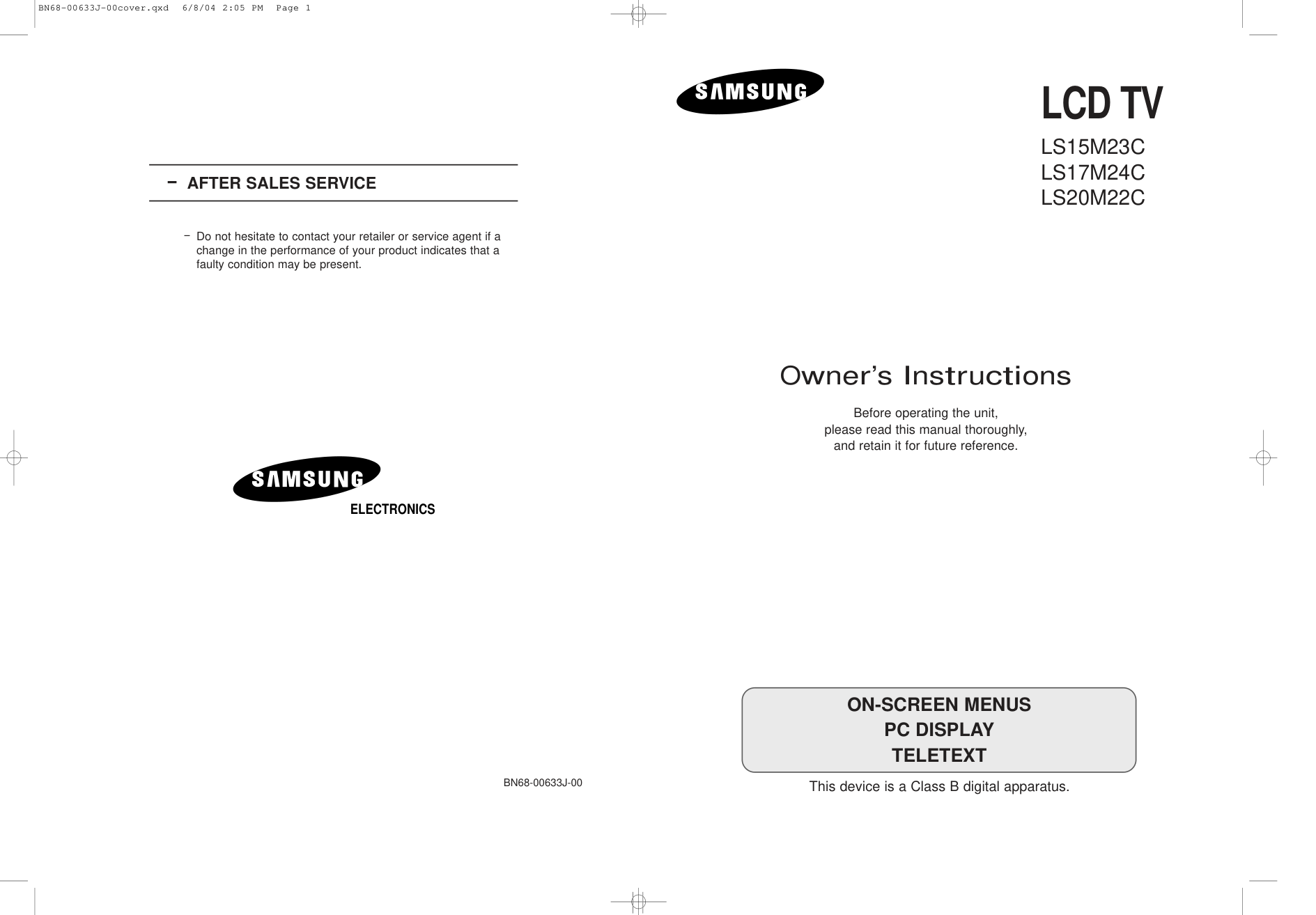)
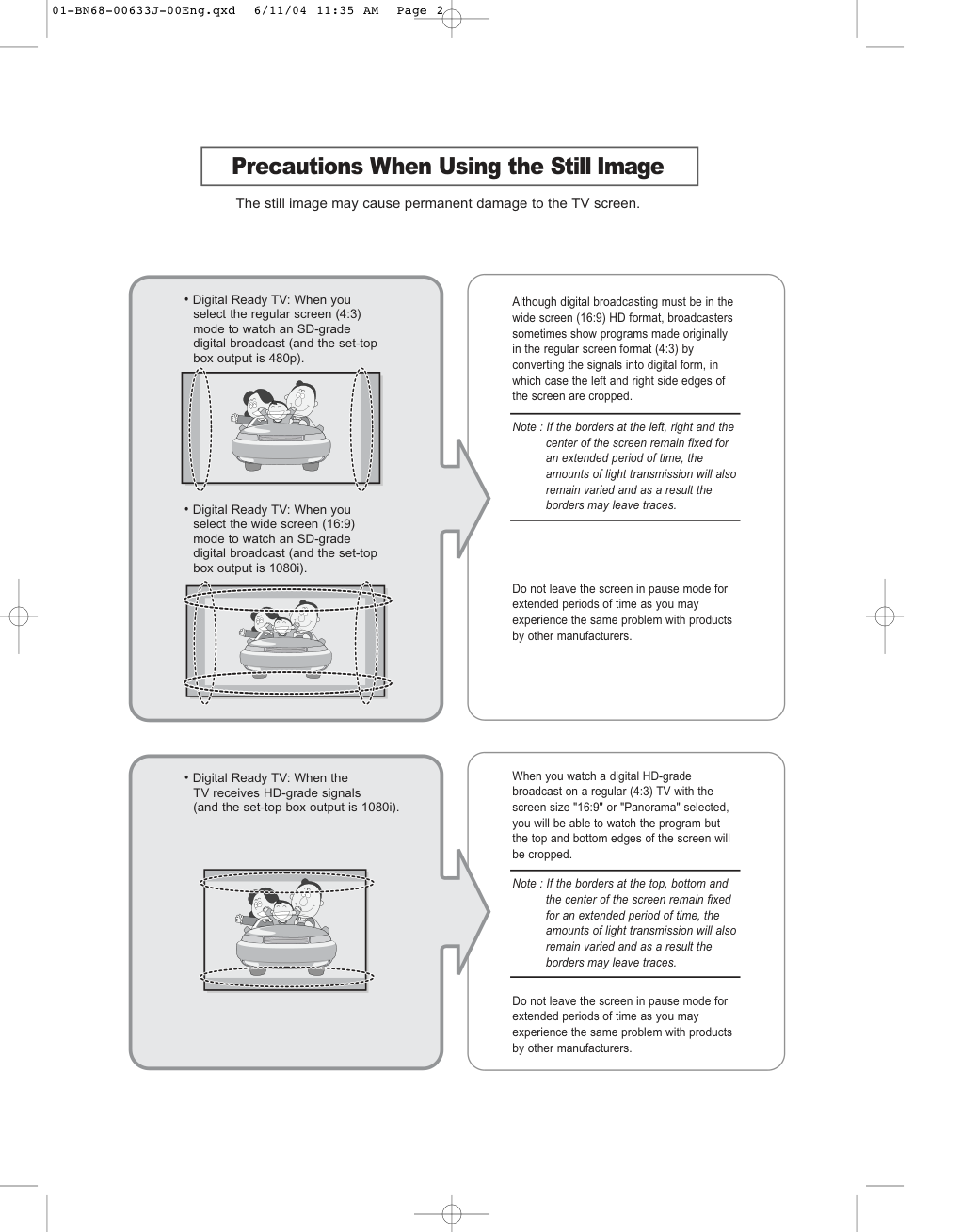)
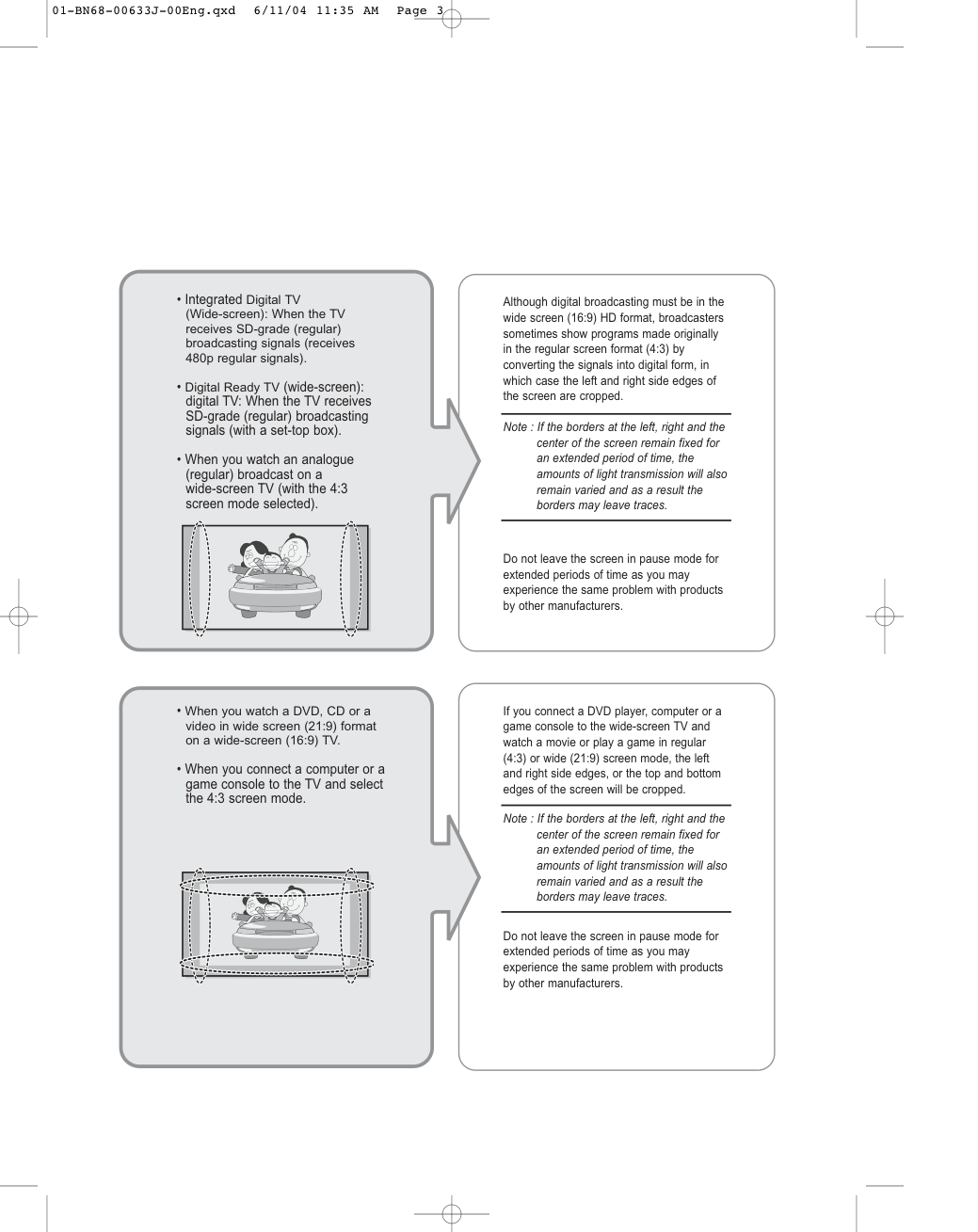)
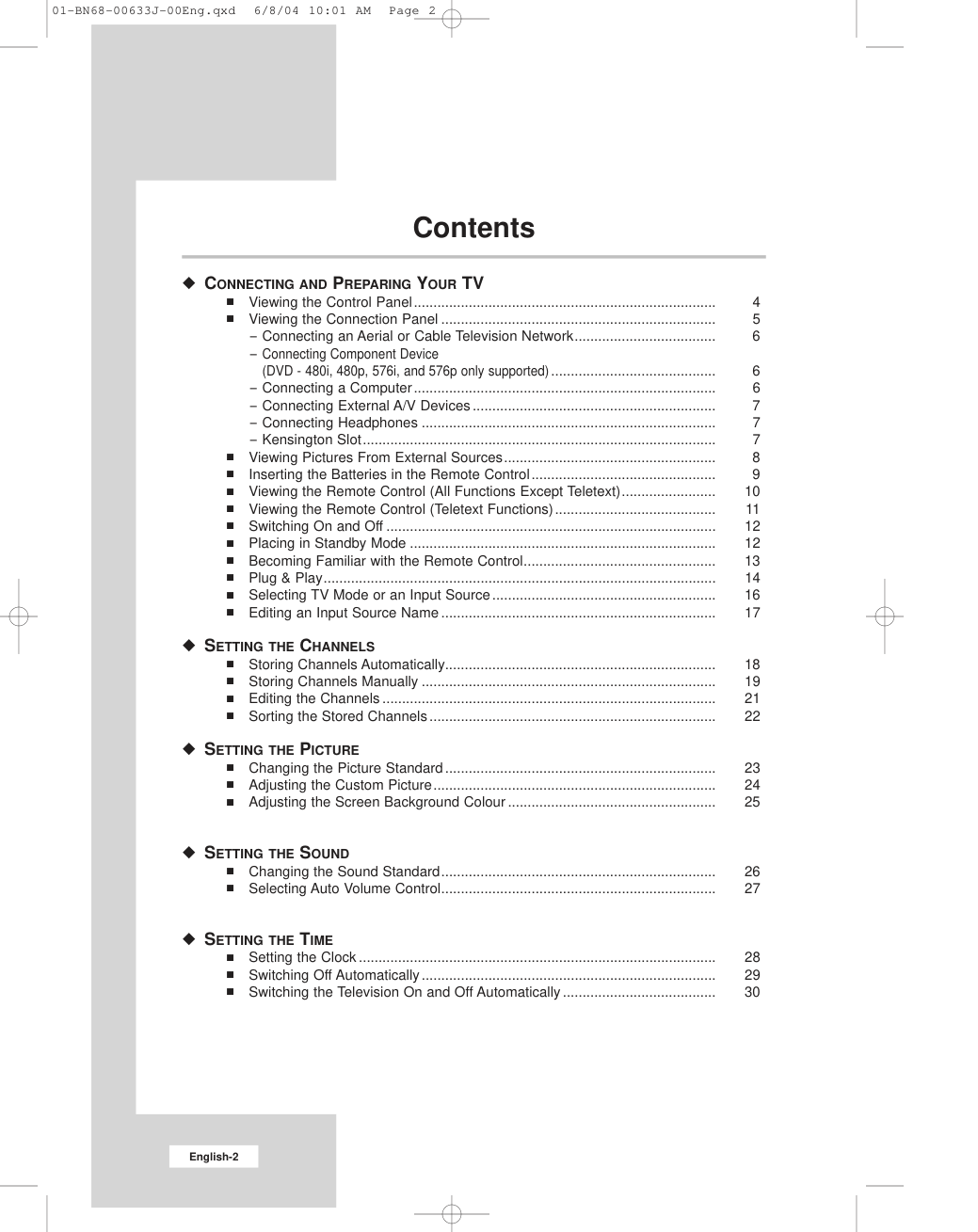)
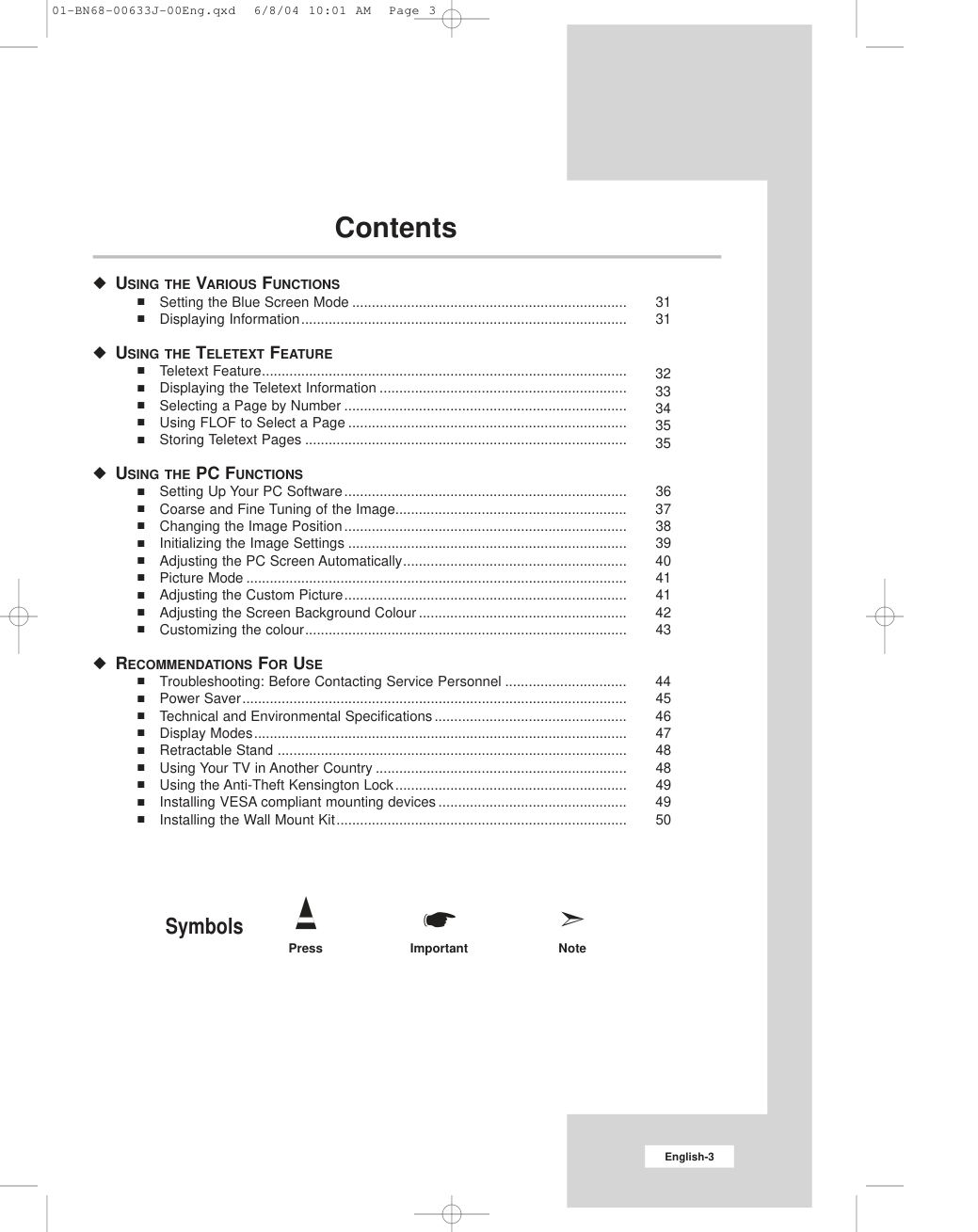)
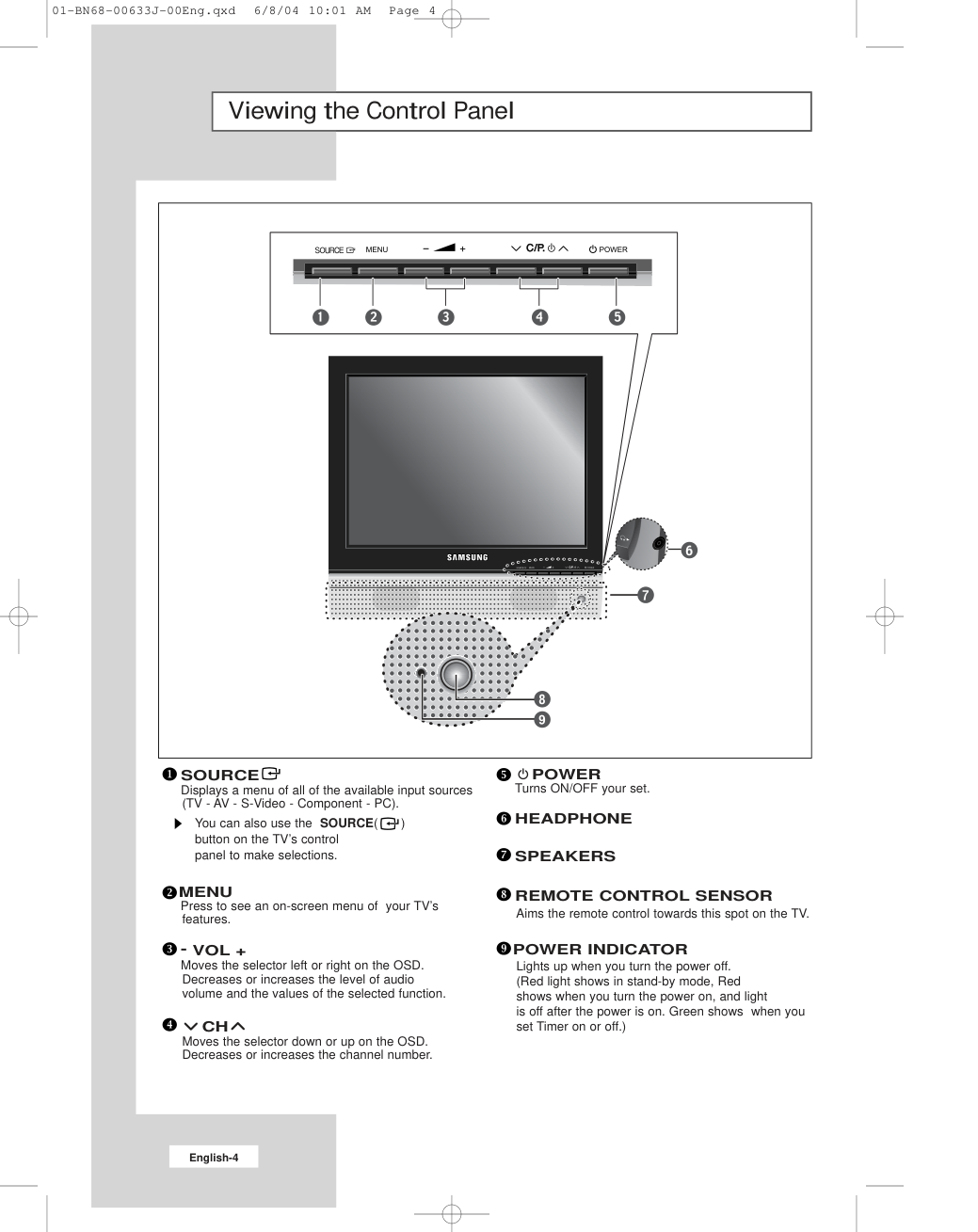)
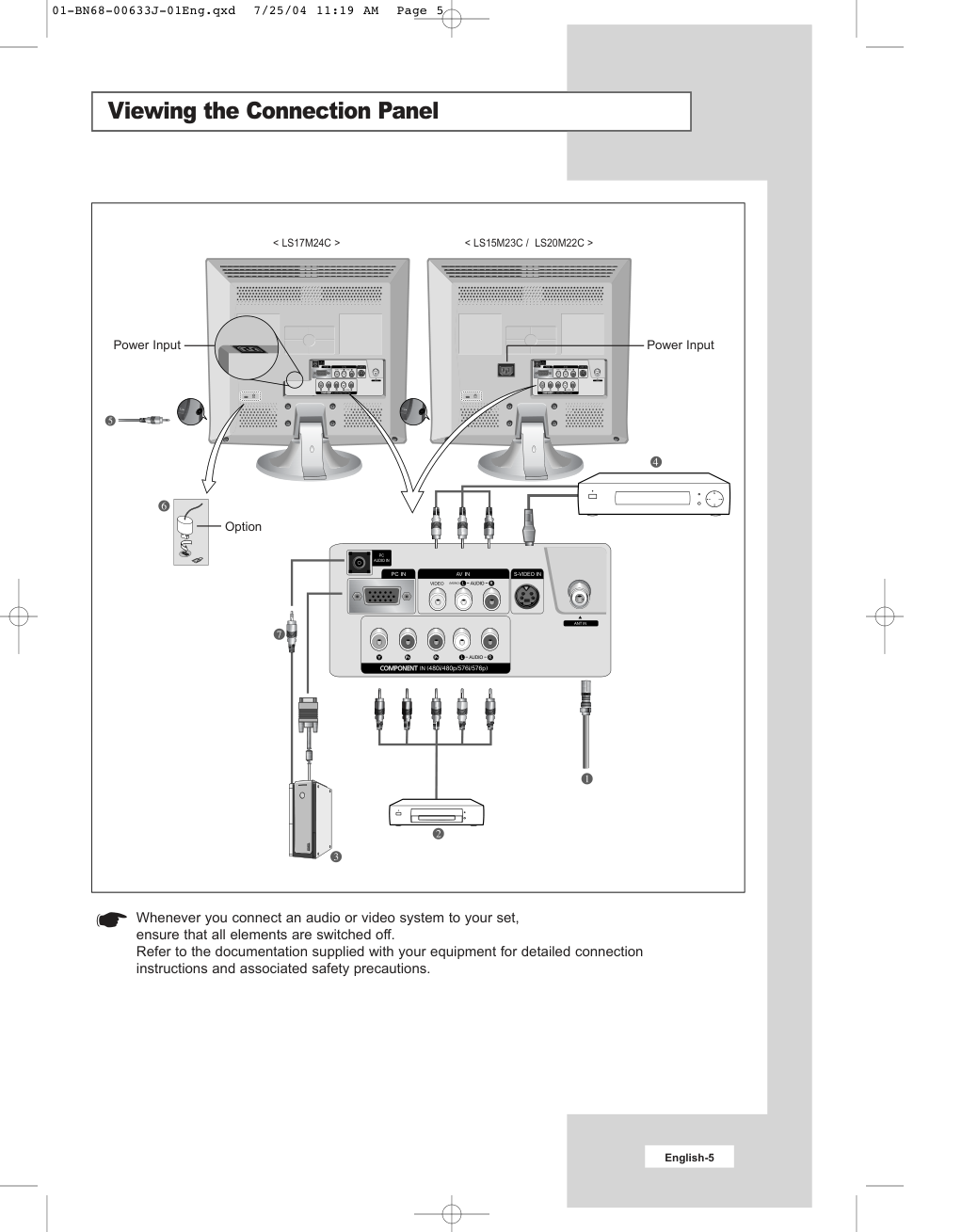)
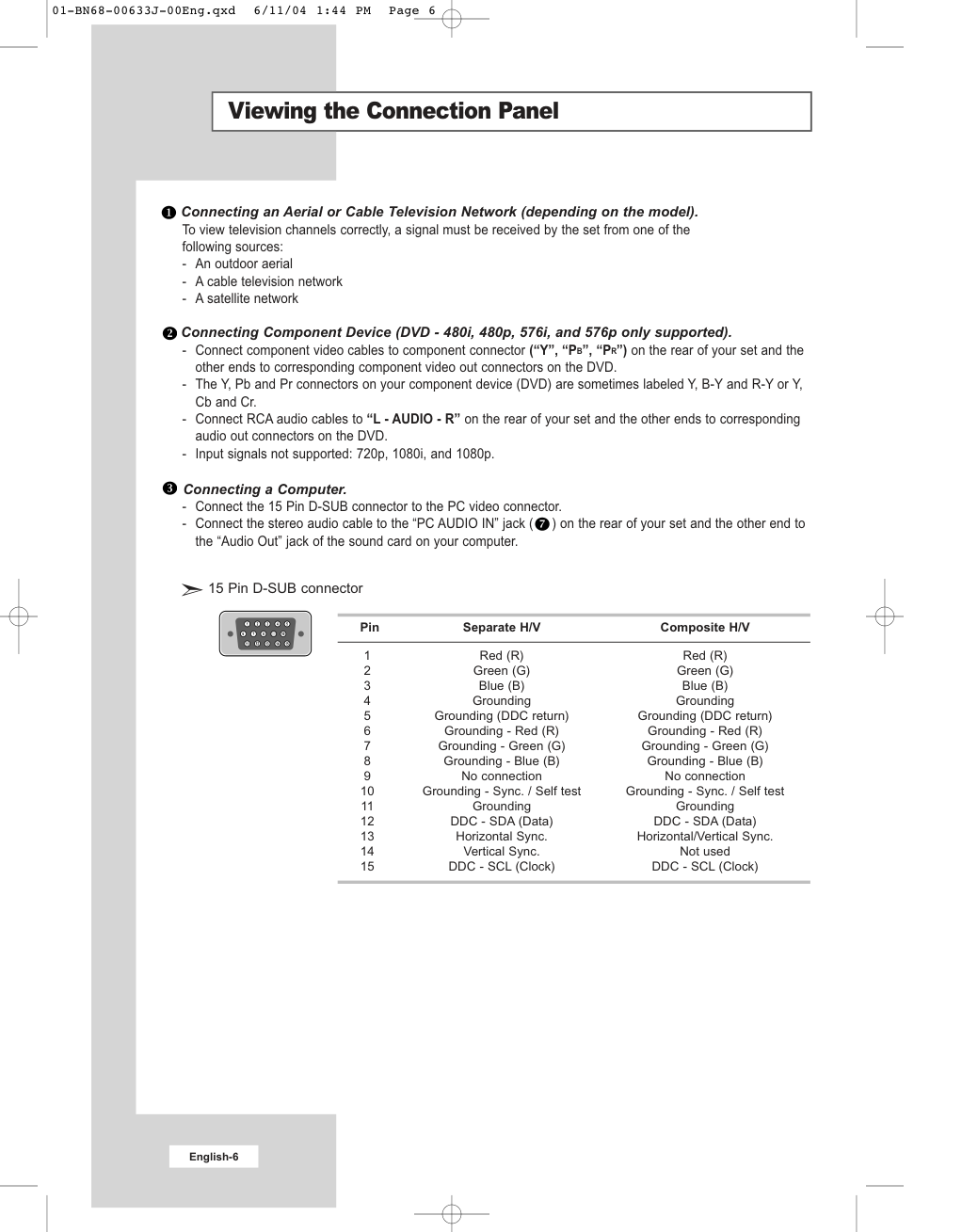)
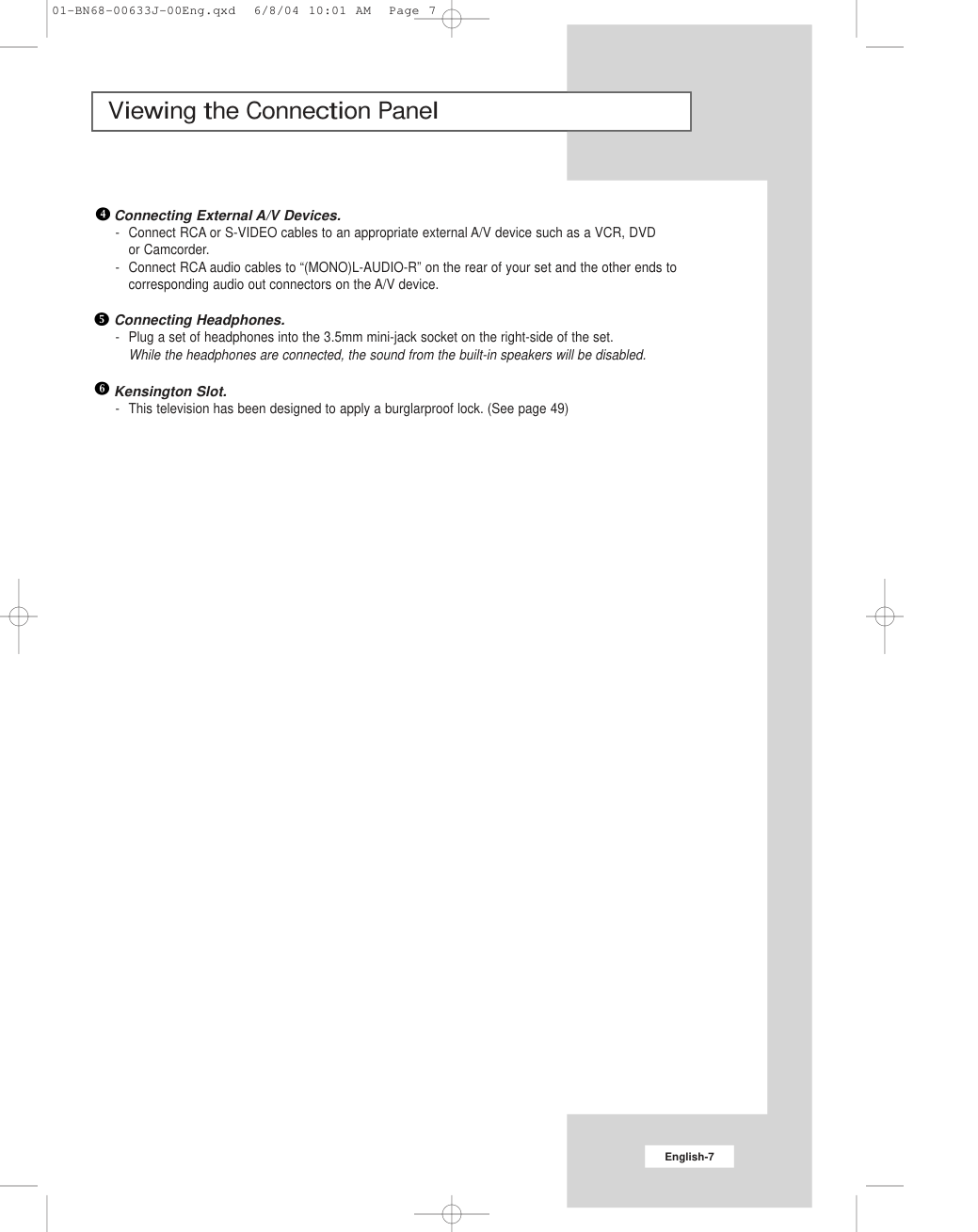)
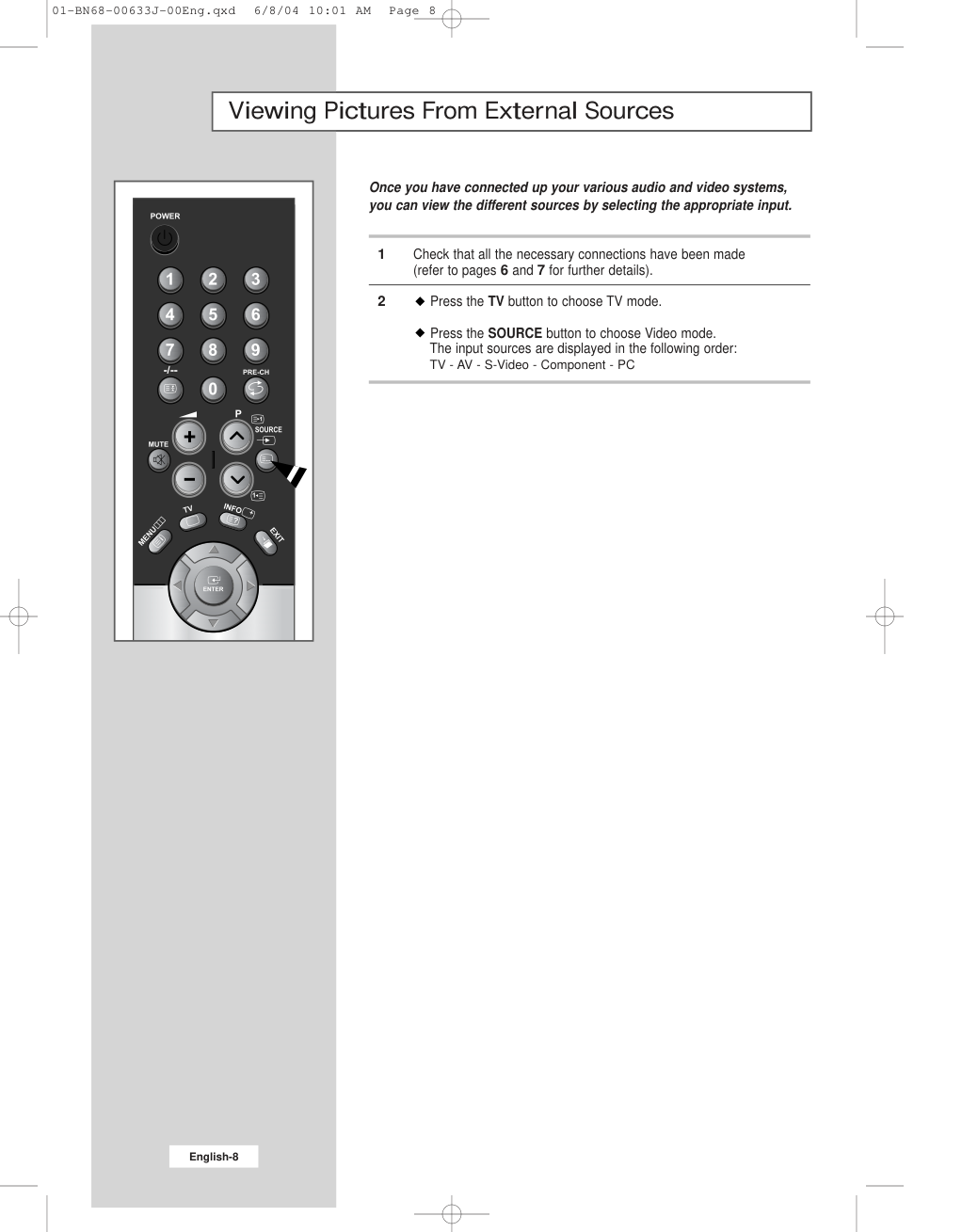)
- AFTER SALES SERVICE
- Do not hesitate to contact your retailer or service agent if a
change in the performance of your product indicates that a
faulty condition may be present.
BN68-00633J-00
ELECTRONICS
LCD TV
LS15M23C
LS17M24C
LS20M22C
Owner’s Instructions
Before operating the unit,
please read this manual thoroughly,
and retain it for future reference.
ON-SCREEN MENUS
PC DISPLAY
TELETEXT
This device is a Class B digital apparatus.
BN68-00633J-00cover.qxd 6/8/04 2:05 PM Page 1
Precautions When Using the Still Image
The still image may cause permanent damage to the TV screen.
• Digital Ready TV: When you
select the regular screen (4:3)
mode to watch an SD-grade
digital broadcast (and the set-top
box output is 480p).
Although digital broadcasting must be in the
wide screen (16:9) HD format, broadcasters
sometimes show programs made originally
in the regular screen format (4:3) by
converting the signals into digital form, in
which case the left and right side edges of
the screen are cropped.
Do not leave the screen in pause mode for
extended periods of time as you may
experience the same problem with products
by other manufacturers.
Note : If the borders at the left, right and the
center of the screen remain fixed for
an extended period of time, the
amounts of light transmission will also
remain varied and as a result the
borders may leave traces.
• Digital Ready TV: When you
select the wide screen (16:9)
mode to watch an SD-grade
digital broadcast (and the set-top
box output is 1080i).
• Digital Ready TV: When the
TV receives HD-grade signals
(and the set-top box output is 1080i).
When you watch a digital HD-grade
broadcast on a regular (4:3) TV with the
screen size "16:9" or "Panorama" selected,
you will be able to watch the program but
the top and bottom edges of the screen will
be cropped.
Do not leave the screen in pause mode for
extended periods of time as you may
experience the same problem with products
by other manufacturers.
Note : If the borders at the top, bottom and
the center of the screen remain fixed
for an extended period of time, the
amounts of light transmission will also
remain varied and as a result the
borders may leave traces.
01-BN68-00633J-00Eng.qxd 6/11/04 11:35 AM Page 2
• Integrated Digital TV
(Wide-screen): When the TV
receives SD-grade (regular)
broadcasting signals (receives
480p regular signals).
• Digital Ready TV (wide-screen):
digital TV: When the TV receives
SD-grade (regular) broadcasting
signals (with a set-top box).
• When you watch an analogue
(regular) broadcast on a
wide-screen TV (with the 4:3
screen mode selected).
Although digital broadcasting must be in the
wide screen (16:9) HD format, broadcasters
sometimes show programs made originally
in the regular screen format (4:3) by
converting the signals into digital form, in
which case the left and right side edges of
the screen are cropped.
Do not leave the screen in pause mode for
extended periods of time as you may
experience the same problem with products
by other manufacturers.
Note : If the borders at the left, right and the
center of the screen remain fixed for
an extended period of time, the
amounts of light transmission will also
remain varied and as a result the
borders may leave traces.
• When you watch a DVD, CD or a
video in wide screen (21:9) format
on a wide-screen (16:9) TV.
• When you connect a computer or a
game console to the TV and select
the 4:3 screen mode.
If you connect a DVD player, computer or a
game console to the wide-screen TV and
watch a movie or play a game in regular
(4:3) or wide (21:9) screen mode, the left
and right side edges, or the top and bottom
edges of the screen will be cropped.
Do not leave the screen in pause mode for
extended periods of time as you may
experience the same problem with products
by other manufacturers.
Note : If the borders at the left, right and the
center of the screen remain fixed for
an extended period of time, the
amounts of light transmission will also
remain varied and as a result the
borders may leave traces.
01-BN68-00633J-00Eng.qxd 6/11/04 11:35 AM Page 3
English-2
Contents
N CONNECTING AND PREPARING YOUR TV
I
Viewing the Control Panel.............................................................................
4
I
Viewing the Connection Panel ......................................................................
5
- Connecting an Aerial or Cable Television Network....................................
6
- Connecting Component Device
(DVD - 480i, 480p, 576i, and 576p only supported)..........................................
6
- Connecting a Computer.............................................................................
6
- Connecting External A/V Devices..............................................................
7
- Connecting Headphones ...........................................................................
7
- Kensington Slot..........................................................................................
7
I
Viewing Pictures From External Sources......................................................
8
I
Inserting the Batteries in the Remote Control...............................................
9
I
Viewing the Remote Control (All Functions Except Teletext)........................
10
I
Viewing the Remote Control (Teletext Functions).........................................
11
I
Switching On and Off ....................................................................................
12
I
Placing in Standby Mode ..............................................................................
12
I
Becoming Familiar with the Remote Control.................................................
13
I
Plug & Play....................................................................................................
14
I
Selecting TV Mode or an Input Source.........................................................
16
I
Editing an Input Source Name ......................................................................
17
N SETTING THE CHANNELS
I
Storing Channels Automatically.....................................................................
18
I
Storing Channels Manually ...........................................................................
19
I
Editing the Channels .....................................................................................
21
I
Sorting the Stored Channels.........................................................................
22
N SETTING THE PICTURE
I
Changing the Picture Standard.....................................................................
23
I
Adjusting the Custom Picture........................................................................
24
I
Adjusting the Screen Background Colour .....................................................
25
N SETTING THE SOUND
I
Changing the Sound Standard......................................................................
26
I
Selecting Auto Volume Control......................................................................
27
N SETTING THE TIME
I
Setting the Clock ...........................................................................................
28
I
Switching Off Automatically...........................................................................
29
I
Switching the Television On and Off Automatically .......................................
30
01-BN68-00633J-00Eng.qxd 6/8/04 10:01 AM Page 2
English-3
Contents
N USING THE VARIOUS FUNCTIONS
I
Setting the Blue Screen Mode ......................................................................
31
I
Displaying Information...................................................................................
31
N USING THE TELETEXT FEATURE
I
Teletext Feature.............................................................................................
32
I
Displaying the Teletext Information ...............................................................
33
I
Selecting a Page by Number ........................................................................
34
I
Using FLOF to Select a Page .......................................................................
35
I
Storing Teletext Pages ..................................................................................
35
N USING THE PC FUNCTIONS
I
Setting Up Your PC Software........................................................................
36
I
Coarse and Fine Tuning of the Image...........................................................
37
I
Changing the Image Position........................................................................
38
I
Initializing the Image Settings .......................................................................
39
I
Adjusting the PC Screen Automatically.........................................................
40
I
Picture Mode .................................................................................................
41
I
Adjusting the Custom Picture........................................................................
41
I
Adjusting the Screen Background Colour .....................................................
42
I
Customizing the colour..................................................................................
43
N RECOMMENDATIONS FOR USE
I
Troubleshooting: Before Contacting Service Personnel ...............................
44
I
Power Saver..................................................................................................
45
I
Technical and Environmental Specifications.................................................
46
I
Display Modes...............................................................................................
47
I
Retractable Stand .........................................................................................
48
I
Using Your TV in Another Country ................................................................
48
I
Using the Anti-Theft Kensington Lock...........................................................
49
I
Installing VESA compliant mounting devices ................................................
49
I
Installing the Wall Mount Kit..........................................................................
50
Press
Important
Note
Symbols
01-BN68-00633J-00Eng.qxd 6/8/04 10:01 AM Page 3
English-4
Viewing the Control Panel
SOURCE
Displays a menu of all of the available input sources
(TV - AV - S-Video - Component - PC).
You can also use the SOURCE(
)
button on the TV’s control
panel to make selections.
MENU
Press to see an on-screen menu of your TV’s
features.
- VOL +
Moves the selector left or right on the OSD.
Decreases or increases the level of audio
volume and the values of the selected function.
CH
Moves the selector down or up on the OSD.
Decreases or increases the channel number.
POWER
Turns ON/OFF your set.
HEADPHONE
SPEAKERS
REMOTE CONTROL SENSOR
Aims the remote control towards this spot on the TV.
POWER INDICATOR
Lights up when you turn the power off.
(Red light shows in stand-by mode, Red
shows when you turn the power on, and light
is off after the power is on. Green shows when you
set Timer on or off.)
01-BN68-00633J-00Eng.qxd 6/8/04 10:01 AM Page 4
English-5
Viewing the Connection Panel
Whenever you connect an audio or video system to your set,
ensure that all elements are switched off.
Refer to the documentation supplied with your equipment for detailed connection
instructions and associated safety precautions.
Option
< LS17M24C >
< LS15M23C / LS20M22C >
Power Input
Power Input
01-BN68-00633J-01Eng.qxd 7/25/04 11:19 AM Page 5
English-6
Viewing the Connection Panel
Connecting an Aerial or Cable Television Network (depending on the model).
To view television channels correctly, a signal must be received by the set from one of the
following sources:
- An outdoor aerial
- A cable television network
- A satellite network
Connecting Component Device (DVD - 480i, 480p, 576i, and 576p only supported).
- Connect component video cables to component connector (“Y”, “PB”, “PR”) on the rear of your set and the
other ends to corresponding component video out connectors on the DVD.
- The Y, Pb and Pr connectors on your component device (DVD) are sometimes labeled Y, B-Y and R-Y or Y,
Cb and Cr.
- Connect RCA audio cables to “L - AUDIO - R” on the rear of your set and the other ends to corresponding
audio out connectors on the DVD.
- Input signals not supported: 720p, 1080i, and 1080p.
Connecting a Computer.
- Connect the 15 Pin D-SUB connector to the PC video connector.
- Connect the stereo audio cable to the “PC AUDIO IN” jack (
) on the rear of your set and the other end to
the “Audio Out” jack of the sound card on your computer.
Pin
Separate H/V
Composite H/V
1
Red (R)
Red (R)
2
Green (G)
Green (G)
3
Blue (B)
Blue (B)
4
Grounding
Grounding
5
Grounding (DDC return)
Grounding (DDC return)
6
Grounding - Red (R)
Grounding - Red (R)
7
Grounding - Green (G)
Grounding - Green (G)
8
Grounding - Blue (B)
Grounding - Blue (B)
9
No connection
No connection
10
Grounding - Sync. / Self test
Grounding - Sync. / Self test
11
Grounding
Grounding
12
DDC - SDA (Data)
DDC - SDA (Data)
13
Horizontal Sync.
Horizontal/Vertical Sync.
14
Vertical Sync.
Not used
15
DDC - SCL (Clock)
DDC - SCL (Clock)
➣ 15 Pin D-SUB connector
01-BN68-00633J-00Eng.qxd 6/11/04 1:44 PM Page 6
English-7
Viewing the Connection Panel
Connecting External A/V Devices.
- Connect RCA or S-VIDEO cables to an appropriate external A/V device such as a VCR, DVD
or Camcorder.
- Connect RCA audio cables to “(MONO)L-AUDIO-R” on the rear of your set and the other ends to
corresponding audio out connectors on the A/V device.
Connecting Headphones.
- Plug a set of headphones into the 3.5mm mini-jack socket on the right-side of the set.
While the headphones are connected, the sound from the built-in speakers will be disabled.
Kensington Slot.
- This television has been designed to apply a burglarproof lock. (See page 49)
01-BN68-00633J-00Eng.qxd 6/8/04 10:01 AM Page 7
English-8
Viewing Pictures From External Sources
Once you have connected up your various audio and video systems,
you can view the different sources by selecting the appropriate input.
1
Check that all the necessary connections have been made
(refer to pages 6 and 7 for further details).
2
Press the TV button to choose TV mode.
Press the SOURCE button to choose Video mode.
The input sources are displayed in the following order:
TV - AV - S-Video - Component - PC
01-BN68-00633J-00Eng.qxd 6/8/04 10:01 AM Page 8
English-9
Inserting the Batteries in the Remote Control
You must insert or replace the batteries in the remote control when you:
Purchase your set.
Find that the remote control is no longer operating correctly.
1
Remove the cover on the rear of the remote control by pressing the
symbol downwards and then pulling firmly to remove it.
2
Install two AAA size batteries.
N
+ on the battery against + on the remote control
N - on the battery against - on the remote control
3
Replace the cover by aligning it with the base of the remote control
and pressing it back into place.
Do not mix battery types, i.e. alkaline and manganese.
01-BN68-00633J-00Eng.qxd 6/8/04 10:01 AM Page 9
English-10
Viewing the Remote Control (All Functions Except Teletext)
Television On/Off
Temporary sound switch-off
Volume up or down
One/Two-digit channel
selection
Available source selection
Use to see information on the
current broadcast.
Exit the OSD
Control the cursor in the menu
Previous channel
-Next channel
-Previous channel
Picture effect selection
Menu display and
change confirmation
Sound effect selection
Numeric buttons for
direct channel access
Automatic switch-off
The performance of the remote control may be affected by bright light.
Sound mode selection
Select to the TV mode directly
01-BN68-00633J-00Eng.qxd 6/8/04 10:02 AM Page 10
English-11
Viewing the Remote Control (Teletext Functions)
Teletext index
Teletext sub page
Teletext mode selection
(LIST/FLOF)
Teletext reveal
P
: Teletext next page
P
: Teletext previous page
Teletext store
Teletext hold
Teletext size selection
Exit from the teletext display
Fastext topic selection
Teletext display/mix
both teletext information
and the normal broadcast
01-BN68-00633J-00Eng.qxd 6/8/04 10:02 AM Page 11
English-12
Switching On and Off
The mains lead is attached to the rear of your set.
1
Plug the mains lead into an appropriate socket.
Result:
When the power cord is plugged in, the LED turns red.
2
Press the
POWER button to switch on.
3
To switch off, press the
POWER button again.
Placing in Standby Mode
Your set can be placed in Standby mode in order to reduce the
power consumption.
The Standby mode can be useful when you wish to interrupt viewing
temporarily (during a meal, for example).
1
Press the
POWER button.
2
To switch back on, simply press the
POWER button again, a
numeric button, or channel
or
button.
Do not leave your set in Standby mode for long periods of time.
(when you are away on holiday, for example)
Turn off by pressing the
POWER button.
It is best to unplug the set from the mains and aerial.
01-BN68-00633J-00Eng.qxd 6/8/04 10:02 AM Page 12
English-13
Becoming Familiar with the Remote Control
The remote control is used mainly to:
Change channels and adjust the volume.
Set up your set using the on-screen menu system.
The following table presents the most frequently used buttons and their
functions.
Button
Viewing Function
Menu Function
Used to display the next
-
stored channel.
Used to display the
-
previous stored channel.
PRE-CH
Used to switch repeatedly between the last two channels
displayed. (PRE-CH; Previous Channel)
-
Used to display the corresponding channels.
-/--
Used to select a channel numbered ten or over.
Press this button, and the “--” symbol is displayed.
Enter the two-digit channel number.
Used to increase the
-
volume.
Used to decrease the
-
volume.
MUTE
Used to switch the sound off temporarily.
To turn the sound back on, press this button again,
or press the + or - button.
MENU
Used to display the
Used to return to the previous
on-screen menu system.
menu or normal viewing.
EXIT
Used to exit the menu system and return directly to normal
viewing.
Used to move among the menu items.
Used to select a menu item or increase
the value of the selected item.
Used to return to the previous menu item or decrease
the value of the selected item.
9
01-BN68-00633J-00Eng.qxd 6/8/04 10:02 AM Page 13
English-14
Plug & Play
When the set is initially powered ON, you are automatically presented
with a series of basic customer settings.
The following settings are available.
1
If the set is in standby mode, press the
POWER button on the
remote control.
Result:
The message Plug & Play is displayed.
It appears for a little while, and then the "Check antenna
input." menu is automatically displayed.
2
The message “Check antenna input.” is displayed with OK
selected.
3
Press the ENTER
button.
Result:
The Area menu is displayed:
Asia/W. Europe - CIS/E. Europe - China -
Hong Kong/UK - Australia - NZL/Indonesia - South
Africa - America
4
Select your Area by pressing the
or
button.
Press the ENTER
button.
Result:
The Auto Store menu is displayed.
5
Press the ENTER
button.
Result:
The channel search will start and end automatically.
6
Select the Hour, Minute or am/pm by pressing the
or
button.
Set the Hour, Minute or am/pm by pressing the
or
button.
(Refer to “Setting the Clock” on page 28)
7
Press the MENU button to confirm your setting.
Result:
The message “Enjoy your viewing” is displayed,
and then the channel which has been stored will be
activated.
8
Press the EXIT button to return to normal viewing.
02-BN68-00633J-00Eng.qxd 6/8/04 10:02 AM Page 14
English-15
Plug & Play
If you want to reset this feature...
1
Press the MENU button.
Result:
The main menu is displayed.
2
Press the
or
button to select the Setup.
Result:
The options available in the Setup group are displayed.
3
Press the ENTER
button.
4
Press the
or
button to select the Plug & Play.
Press the ENTER
button.
Result:
The message Plug & Play is displayed.
5
For further details on how to set up this feature, refer to the
previous page.
02-BN68-00633J-00Eng.qxd 6/8/04 10:02 AM Page 15
English-16
Selecting TV Mode or an Input Source
You can choose TV mode or change to an input source connected to
the TV set. Use this button to choose an input source that you would
like to watch.
1
Press the MENU button.
Result:
The main menu is displayed.
2
Press the ENTER
button to select the Input.
Result:
The options available in the Input group are displayed.
3
Press the ENTER
button.
Result:
The Source List is selected.
4
Press the
or
button to move to the input source that
you wish to choose.
Press the ENTER
button.
Result:
The input source changes to the one you have chosen.
02-BN68-00633J-00Eng.qxd 6/8/04 10:02 AM Page 16
English-17
Editing an Input Source Name
Entering the names of the input source devices connected to the input
ports on the TV set allows you to find and choose an input source that
you would like to watch in a quick and convenient manner.
1
Press the MENU button.
Result:
The main menu is displayed.
2
Press the ENTER
button to select the Input.
Result:
The options available in the Input group are displayed.
3
Press the
or
button to select the Edit Name.
Press the ENTER
button.
4
Press the
or
button to move to the input source that
you wish to edit.
Press the ENTER
button.
Result:
The following options are available:
AV - S-Video - Component - PC
5
Select the required device by pressing the
or
repeatedly.
Result:
The following options are available:
---- - VCR - DVD - Cable STB - HD STB - Satellite STB -
AV Receiver - DVD Receiver - Game - Camcorder -
DVD Combo - DHR - PC
6
When you are satisfied with your choice, press the EXIT button to
return to normal viewing.
02-BN68-00633J-00Eng.qxd 6/8/04 10:02 AM Page 17
English-18
Storing Channels Automatically
You can scan for the frequency ranges available to you (and availability
depends on your country). Automatically allocated programme numbers
may not correspond to actual or desired programme numbers.
However you can sort numbers manually and clear any channels you
do not wish to watch.
1
Press the MENU button.
Result:
The main menu is displayed.
2
Press the
or
button to select the Channel.
Result:
The options available in the Channel group are displayed.
3
Press the ENTER
button.
4
Press the
or
button to select Auto Store.
Press the ENTER
button.
Result:
The Start is selected.
5
Press the ENTER
button to search the channels.
The sub menu is changed from Start to Stop with channel
search started.
Result:
The search will end automatically.
Channels are sorted and stored in an order which reflects
their position in the frequency range, (with lowest first and
highest last). The programme originally selected is then
displayed.
To stop the search before it has finished, press the ENTER
button to search the channels.
6
When the channels have been stored, you can:
Add or delete the channels (refer to page 21)
Sort them in the order required (refer to page 22)
7
Press the EXIT button to return to normal viewing.
40
02-BN68-00633J-00Eng.qxd 6/8/04 10:02 AM Page 18
English-19
Storing Channels Manually
You can store up to 100 channels, including those received via
cable networks.
When storing channels manually, you can choose:
Whether or not to store each of the channels found.
The programme number of each stored channel which you wish to
identify.
1
Press the MENU button.
Result:
The main menu is displayed.
2
Press the
or
button to select the Channel.
Result:
The options available in the Channel group are displayed.
3
Press the ENTER
button.
4
Press the
or
button to select the Manual Store.
Press the ENTER
button.
Result:
The options available in the Manual Store group are
displayed with the Prog. selected.
5
Press the ENTER
button again.
To assign a programme number to a channel, find the correct
number by pressing the
or
button and then press the
ENTER
button.
6
Press the
or
button to select Colour System.
Press the ENTER
button.
Select the Colour System required by pressing the
or
button
repeatedly and then press the ENTER
button.
Result:
The colour standards are displayed in the following order:
AUTO - PAL - SECAM - NTSC4.43 - NTSC3.58
7
Press the
or
button to select Sound System.
Press the ENTER
button.
Select the Sound System required by pressing the
or
button
repeatedly and then press the ENTER
button.
Result:
The sound standards are displayed in the following order:
BG - DK - I - M
8
For all the channels to move to the required channel numbers,
repeat steps 5 to 7 after selecting Prog. by pressing the
or
button.
02-BN68-00633J-00Eng.qxd 6/8/04 10:02 AM Page 19
English-20
Storing Channels Manually
9
If you know the channel number to be stored,
Press the
or
button to select the Channel.
Press the ENTER
button.
Select C (Air channel) or S (Cable channel) by pressing the
or
button and then press the ENTER
button.
Press the button to select the Channel.
Select the required number by pressing the
or
button
and then press the ENTER
button.
If there is normal sound or no sound, re-select the
sound system required.
10
If you do not know the channel numbers, press the
or
button
to select Search.
Press the ENTER
button.
Start the Search by pressing the
or
button.
Press the ENTER
button.
Result:
The tuner scans the frequency range until the first channel
or the channel that you selected is received on your screen.
11
Press the
or
button to select Store.
Press the ENTER
button.
The OK is selected.
Result:
The channel and associated programme number are
stored.
12
Repeat Steps 9 to 11 for each channel to be stored.
13
Press the EXIT button to return to normal viewing.
Channel mode
P (Programme mode): When tuning is completed, the broadcasting
stations in your area will have been assigned to position numbers
from P00 to P99. You can select a channel by entering the position
number in this mode.
C (Real channel mode): You can select a channel by entering the
assigned number to each broadcast station in this mode.
S (Cable channel mode): You can select a channel by entering the
assigned number to each cable channel in this mode.
02-BN68-00633J-00Eng.qxd 6/8/04 10:02 AM Page 20
English-21
Editing the Channels
You can exclude any channels of your choice from the channels you
have scanned. When you scan through the stored channels, those you
have chosen to skip are not displayed.
All channels that you do not specifically choose to skip are displayed
during scanning.
1
Press the MENU button.
Result:
The main menu is displayed.
2
Press the
or
button to select the Channel.
Result:
The options available in the Channel group are displayed.
3
Press the ENTER
button.
4
Press the
or
button to select Add/Delete.
Press the ENTER
button.
Result:
The state of the current channel is displayed.
5
Press the
or
button to select the channel that you wish to
Add or Delete.
Result:
If the channel that you wish to edit is not in memory,
Add is selected and displayed.
Otherwise, if the channel that you wish to edit is in memory,
Delete is selected and displayed.
6
Press the ENTER
button to Add or Delete the channel.
7
Repeat Step 5 and 6 for each channel to be added or erased.
8
Press the EXIT button to return to normal viewing.
02-BN68-00633J-00Eng.qxd 6/8/04 10:02 AM Page 21
English-22
Sorting the Stored Channels
You can exchange the numbers of two channels, in order to:
Modify the numeric order in which the channels have been
automatically stored.
Assign easily remembered numbers to the channels that you watch
most often.
1
Press the MENU button.
Result:
The main menu is displayed.
2
Press the
or
button to select the Channel.
Result:
The options available in the Channel group are displayed.
3
Press the ENTER
button.
4
Press the
or
button to select Sort.
Press the ENTER
button.
Result:
The current Prog. and Channel are displayed.
5
Select the channel number that you wish to change by pressing
the
or
button repeatedly.
Press the ENTER
button.
Result:
The selected Channel is moved to the right side.
6
Press the
or
button to move to the position which you would
like to change and then press the ENTER
button.
Result:
The selected channel is exchanged with the one
previously stored to the chosen number.
7
Repeat step 5 to 6 for another channel to sort again.
8
Press the EXIT button to return to normal viewing.
02-BN68-00633J-00Eng.qxd 6/8/04 10:02 AM Page 22
English-23
Changing the Picture Standard
You can select the type of picture which best corresponds to your
viewing requirements.
1
Press the MENU button.
Result:
The main menu is displayed.
2
Press the
or
button to select the Picture.
Result:
The options available in the Picture group are displayed.
3
Press the ENTER
button.
Result:
The Mode is selected.
4
Press the ENTER
button.
5
Select the required picture effect by pressing the
or
button
repeatedly.
Press the ENTER
button.
Result:
The following picture effects are available:
Dynamic - Standard - Movie - Custom
6
Press the EXIT button to return to normal viewing.
You can also set these options simply by pressing the
P.MODE (Picture Mode) button.
02-BN68-00633J-00Eng.qxd 6/8/04 10:02 AM Page 23
Your set has several settings which allow you to control picture quality.
1
Press the MENU button.
Result:
The main menu is displayed.
2
Press the
or
button to select the Picture.
Result:
The options available in the Picture group are displayed.
3
Press the ENTER
button.
4
Press the
or
button to select the Custom.
Press the ENTER
button.
5
Select the option (Contrast, Brightness, Sharpness, or
Colour) to be adjusted by pressing the
or
button.
Press the ENTER
button.
Result:
The horizontal bar is displayed.
6
Press the
or
button to reach the required setting.
7
When you are satisfied with the setting, press the MENU button
to return to the previous menu or press the EXIT button to return to
normal viewing.
If you make any changes to these settings,
the picture standard is automatically switched to Custom.
English-24
Adjusting the Custom Picture
02-BN68-00633J-00Eng.qxd 6/8/04 10:02 AM Page 24
English-25
Adjusting the Screen Background Colour
You can change the screen background colour according to your
preference.
1
Press the MENU button.
Result:
The main menu is displayed.
2
Press the
or
button to select the Picture.
Result:
The options available in the Picture group are displayed.
3
Press the ENTER
button.
4
Press the
or
button to select the Colour Tone.
Press the ENTER
button.
Result:
The following options are available:
Cool 2 - Cool 1 - Normal - Warm 1 - Warm 2
5
When you are satisfied with your choice, press the EXIT button
to return to normal viewing.
02-BN68-00633J-00Eng.qxd 6/8/04 10:02 AM Page 25
English-26
Changing the Sound Standard
You can select the type of special sound effect to be used when
watching a given broadcast.
1
Press the MENU button.
Result:
The main menu is displayed.
2
Press the
or
button to select the Sound.
Result:
The options available in the Sound group are displayed.
3
Press the ENTER
button.
Result:
The Mode is selected .
4
Press the ENTER
button.
5
Select the required sound effect by pressing the
or
button
repeatedly.
Press the ENTER
button.
Result:
The following sound effects are available:
Standard - Speech
6
Press the EXIT button to return to normal viewing.
You can also set these options simply by pressing the
S.MODE (Sound Mode) button.
03-BN68-00633J-00Eng.qxd 6/8/04 10:03 AM Page 26
English-27
Selecting Auto Volume Control
Reduces the differences in volume level between broadcasters.
1
Press the MENU button.
Result:
The main menu is displayed.
2
Press the
or
button to select the Sound.
Result:
The options available in the Sound group are displayed.
3
Press the ENTER
button.
4
Press the
or
button to select Auto Volume.
Press the ENTER
button.
5
Press the
or
button to select Off/On.
Press the ENTER
button.
6
Press the EXIT button to return to normal viewing.
03-BN68-00633J-00Eng.qxd 6/8/04 10:03 AM Page 27
English-28
Setting the Clock
You can set the TV’S clock so that the current time is displayed when
you press the "INFO" button. You must also set the time if you wish to
use the automatic On/Off timers.
If you disconnect the power cord, you have to set the
clock again.
1
Press the MENU button.
Result:
The main menu is displayed.
2
Press the
or
button to select Setup.
Result:
The options available in the Setup group are displayed.
3
Press the ENTER
button.
4
Press the ENTER
button.
Result:
The Time menu is displayed with Clock selected.
5
Press the ENTER
button.
6
To...
Press the...
Move to Hour, Minute or am/pm
or
button
Set the hour, minute or am/pm
or
button
7
When you have satisfied with the setting, press the MENU button
to return to the previous menu or press the EXIT button to return
to normal viewing.
03-BN68-00633J-00Eng.qxd 6/8/04 10:03 AM Page 28
English-29
Switching Off Automatically
You can select a time period of between Off and 180 minutes after which
your set automatically switches off.
1
Press the MENU button.
Result:
The main menu is displayed.
2
Press the
or
button to select Setup.
Result:
The options available in the Setup group are displayed.
3
Press the ENTER
button.
4
Press the ENTER
button.
Result:
The Time menu are displayed with Clock selected.
5
Press the
or
button to select the Sleep Timer.
Press the ENTER
button.
6
Press the
or
button repeatedly and cycle through the preset
time intervals.
Result:
The preset time intervals:
Off, 30, 60, 90, 120, 150, 180 minutes.
7
To cancel the sleep timer function, select "Off" by pressing the
or
button.
Press the ENTER
button.
8
Press the EXIT button to return to normal viewing.
You can set the sleep timer by simply pressing the "SLEEP" button on
the remote control.
1
Press the SLEEP button on the remote control.
Result:
If the sleep timer is not yet set, Off is displayed.
Otherwise, the remaining time before which the television
switches to Standby mode is displayed.
2
Select the preset time interval for staying on by pressing the SLEEP
button repeatedly.
03-BN68-00633J-00Eng.qxd 6/8/04 10:03 AM Page 29
English-30
Switching the Television On and Off Automatically
You can set the On/Off timers so that the set will:
Switch on automatically and tune to the channel of your choice
at the time you select.
Switch off automatically at the time you select.
1
Press the MENU button.
Result:
The main menu is displayed.
2
Press the
or
button to select Setup.
Result:
The options available in the Setup group are displayed.
3
Press the ENTER
button.
4
Press the ENTER
button.
Result:
The Time menu are displayed with Clock selected.
5
Press the
or
button to select the On Timer.
Press the ENTER
button.
Result:
The On Timer menu is displayed.
6
Set the time, channel and volume level at which you wish the set
to be switched on.
To...
Press the...
Move to Hour, Minute, am/pm,
or
button
Channel, and Volume
Set Hour, Minute, am/pm, Channel
or
button
and Volume level
Move to Setup
or
button
Select On to enable above setting
or
button
Press the ENTER
button.
7
Press the
or
button to select Off Timer.
In the same way, set the time at which you wish the set to be
switched off automatically.
03-BN68-00633J-00Eng.qxd 6/8/04 10:03 AM Page 30
English-31
Setting the Blue Screen Mode
Displaying Information
If no signal is being received or the signal is very weak, a blue screen
automatically replaces the noisy picture background.
If you wish to continue viewing the poor picture, you must set the
"Blue Screen" mode to "Off".
1
Press the MENU button.
Result:
The main menu is displayed.
2
Press the
or
button to select Setup.
Result:
The options available in the Setup group are displayed.
3
Press the ENTER
button.
4
Press the
or
button to select Blue Screen.
Press the ENTER
button.
5
Select the required option (On or Off) by pressing the
or
button.
6
Press the EXIT button to return to normal viewing.
You can view the setting status of the selected source by pressing the
"INFO" button on the remote control.
The information displayed varies according to the selected source.
03-BN68-00633J-00Eng.qxd 6/8/04 10:03 AM Page 31
English-32
Teletext Feature
Most television channels provide written information services
via teletext.
Information provided includes:
Television programme times.
News bulletins and weather forecasts.
Sports results.
Travel information.
This information is divided into numbered pages (see diagram).
Part
Contents
A
Selected page number
B
Broadcasting channel identity
C
Current page number or search indicators
D
Date and time
E
Text
F
Status information
FASTEXT information
Teletext information is often divided between several pages displayed
in sequence, which can be accessed by:
Entering the page number.
Selecting a title in a list.
Selecting a coloured heading (FASTEXT system).
03-BN68-00633J-00Eng.qxd 6/8/04 10:03 AM Page 32
English-33
Displaying the Teletext Information
You can display Teletext information at any time on your set.
☛
For Teletext information to be displayed correctly,
channel reception must be stable; otherwise:
N
Information may be missing.
N
Some pages may not be displayed.
1
Select the channel providing the Teletext service using the
or
button.
2
Press the TTX/MIX button to activate the teletext mode.
Result:
The contents page is displayed. It can be redisplayed
at any time by pressing the
(index) button.
3
If you wish to display the actual broadcast at the same time as the
teletext page, press the TTX/MIX button again.
4
Press the TV(
) button again to exit the teletext display.
03-BN68-00633J-00Eng.qxd 6/8/04 10:03 AM Page 33
English-34
Selecting a Page by Number
You can enter the page number directly by pressing the numeric
buttons on the remote control.
1
Enter the three-digit page number given in the content by pressing
the corresponding numeric buttons.
Result:
The current page counter is incremented and the page
is then displayed.
2
If the selected page is linked with several secondary pages,
the secondary pages are displayed in sequence.
To freeze the display on a given page, press the
(hold) button.
Press the
(hold) button again to resume.
Using the various display options:
To display...
Press the...
N Hidden text
(reveal)
(answers to quiz games, for example)
N The normal screen
(reveal) again
N A secondary page
(subpage)
by entering its 4-digit number
N The next page
(page up)
N The previous page
(page down)
N Double-size letters in the:
(size)
• Upper half of the screen
• Once
• Lower half of the screen
• Twice
N Normal screen
• Three times
03-BN68-00633J-00Eng.qxd 6/8/04 10:03 AM Page 34
English-35
Using FLOF to Select a Page
The various topics included in the teletext pages are colour-coded, and
can be selected by pressing the coloured buttons on the remote control.
1
Display the teletext contents page by pressing the TTX/MIX button.
2
Press the coloured button corresponding to the topic that you wish
to select; the available topics are given on the status line.
Result:
The page is displayed with other coloured information
that can be selected in the same way.
3
To display the previous or next page, press the corresponding
coloured button.
4
To display the subpage, see the following steps.
N
Press the
(subpage) button.
Result:
The available subpages appear.
N
Select the required subpage.
Subpages can be scrolled by using the
or
button.
Storing Teletext Pages
You can store up to four teletext pages to display them later at leisure.
1
Select the LIST mode using the
(LIST/FLOF) button.
Result:
Four 3-digit numbers are displayed in different colours.
The
(LIST/FLOF) button is used to switch between
the LIST and FLOF modes.
2
Press the coloured button corresponding to the page that will be
replaced.
3
Enter the new page number using the numeric buttons.
4
Repeat steps 2 and 3 for each page to be stored, using a different
coloured button each time.
5
Press the
(store) button until the corresponding blocks blink.
03-BN68-00633J-00Eng.qxd 6/8/04 10:03 AM Page 35
English-36
Setting Up Your PC Software (Based on Windows XP)
The Windows display-settings for a typical computer are shown below. The actual screens on your PC
will probably be different, depending upon your particular version of Windows and your particular video
card. However, even if your actual screens look different, the same basic set-up information will apply in
almost all cases. (If not, contact your computer manufacturer or Samsung Dealer.)
1
First, click on “Control Panel” on the Windows start
menu.
4
Navigate to the “Settings” tab on the display dialog-box.
The correct size setting (resolution)
- refer to page 45, 47
If a vertical-frequency option exists on your display
settings dialog box, the correct value is “60” or “60 Hz”.
Otherwise, just click “OK” and exit the dialog box.
3
When the control panel window
appears, click on “Display” and a
display dialog-box will appear.
2
When the control panel window
appears, click on “Appearance and
Themes” and a display dialog-box will
appear.
03-BN68-00633J-00Eng.qxd 6/8/04 10:03 AM Page 36
English-37
Coarse and Fine Tuning of the Image
1
Press the MENU button.
Result:
The main menu is displayed.
2
Press the
or
button to select Setup.
Result:
The options available in the Setup group are displayed.
3
Press the ENTER
button.
4
Press the
or
button to select PC.
Press the ENTER
button.
Result:
The options available in the PC menu
are displayed.
5
Press the ENTER
button.
Result:
The Image Lock menu is selected.
6
Press the
or
button to select Coarse or Fine.
Press the ENTER
button.
Result:
The horizontal bar is displayed.
7
Press the
or
button to adjust the screen quality.
Vertical stripes may appear or the picture may become blurry.
8
When you are satisfied with the settings, press the MENU button
to return to the previous menu or press the EXIT button to return to
normal viewing.
Preset to PC mode by pressing the SOURCE button on the remote contol.
The purpose of picture quality adjustment is to remove or reduce picture
noise. If the noise is not removed by Fine tuning alone, then adjust the
frequency as best as possible (coarse) and Fine tune again.
After the noise has been reduced, re-adjust the picture so that it is
aligned on the center of screen.
03-BN68-00633J-00Eng.qxd 6/8/04 10:03 AM Page 37
English-38
Changing the Image Position
1
Press the MENU button.
Result:
The main menu is displayed.
2
Press the
or
button to select Setup.
Result:
The options available in the Setup group are displayed.
3
Press the ENTER
button.
4
Press the
or
button to select PC.
Press the ENTER
button.
Result:
The options available in the PC menu
are displayed.
5
Press the
or
button to select Position.
Press the ENTER
button.
Result:
You can adjust the image Position.
6
Press the
or
button to adjust the vertical position.
Press the
or
button to adjust the horizontal position.
7
Press the MENU button to return to the previous menu or
press the EXIT button to return to normal viewing.
Preset to PC mode by pressing the SOURCE button on the remote contol.
03-BN68-00633J-00Eng.qxd 6/8/04 10:03 AM Page 38
English-39
Initializing the Image Settings
You can replace all image settings with the factory default values.
1
Press the MENU button.
Result:
The main menu is displayed.
2
Press the
or
button to select Setup.
Result:
The options available in the Setup group are displayed.
3
Press the ENTER
button.
4
Press the
or
button to select PC.
Press the ENTER
button.
Result:
The options available in the PC menu are
displayed.
5
Press the
or
button to select Image Reset.
Press the ENTER
button.
Result:
The message “Image Reset has completed.” is
displayed.
6
Press the MENU button to return to the previous menu or
press the EXIT button to return to normal viewing.
Preset to PC mode by pressing the SOURCE button on the remote contol.
03-BN68-00633J-00Eng.qxd 6/8/04 10:03 AM Page 39
English-40
Auto adjustment allows the PC screen of set to self-adjust to the
incoming PC video signal.
The values of fine, coarse and position are adjusted automatically.
Adjusting the PC Screen Automatically
1
Press the MENU button.
Result:
The main menu is displayed.
2
Press the
or
button to select Setup.
Result:
The options available in the Setup group are displayed.
3
Press the ENTER
button.
4
Press the
or
button to select PC.
Press the ENTER
button.
Result:
The options available in the PC menu
are displayed.
5
Press the
or
button to select Auto adjustment.
Press the ENTER
button.
Result:
The screen quality and position are automatically adjusted,
and the screen returns to the original view a few seconds
later.
6
Press the MENU button to return to the previous menu or
press the EXIT button to return to normal viewing.
Preset to PC mode by pressing the SOURCE button on the remote contol.
04-BN68-00633J-00Eng.qxd 6/8/04 10:04 AM Page 40
English-41
Picture Mode
You can select the type of picture which best corresponds to your
viewing requirements.
1
Press the MENU button.
Result:
The main menu is displayed.
2
Press the
or
button to select the Picture.
Result:
The options available in the Picture group are displayed.
3
Press the ENTER
button.
Result:
The Mode is selected.
4
Press the ENTER
button.
5
Select the required picture effect by pressing the
or
button
repeatedly. Press the ENTER
button.
Result:
The following picture effects are available:
Entertain - Internet - Text - Custom
6
Press the EXIT button to return to normal viewing.
Adjusting the Custom Picture
Your set has several settings which allow you to control picture quality.
1
Press the MENU button.
Result:
The main menu is displayed.
2
Press the
or
button to select the Picture.
Result:
The options available in the Picture group are displayed.
3
Press the ENTER
button.
4
Press the
or
button to select the Custom.
Press the ENTER
button.
5
Select the option (Contrast, Brightness) to be adjusted by
pressing the
or
button.
Press the ENTER
button.
Result:
The horizontal bar is displayed.
6
Press the
or
button to reach the required setting.
7
When you are satisfied with the setting, press the MENU button
to return to the previous menu or press the EXIT button to return to
normal viewing.
If you make any changes to these settings,
the picture standard is automatically switched to Custom.
04-BN68-00633J-00Eng.qxd 6/8/04 10:04 AM Page 41
English-42
Adjusting the Screen Background Colour
You can change the screen background colour according to your
preference.
1
Press the MENU button.
Result:
The main menu is displayed.
2
Press the
or
button to select the Picture.
Result:
The options available in the Picture group are displayed.
3
Press the ENTER
button.
4
Press the
or
button to select the Colour Tone.
Press the ENTER
button.
Result:
The following options are available:
Cool - Normal - Warm - Custom
5
When you are satisfied with your choice, press the EXIT button
to return to normal viewing.
04-BN68-00633J-00Eng.qxd 6/8/04 10:04 AM Page 42
English-43
Customizing the Colour
1
Press the MENU button.
Result:
The main menu is displayed.
2
Press the
or
button to select the Picture.
Result:
The options available in the Picture group are displayed.
3
Press the ENTER
button.
4
Press the
or
button to select the Colour Control.
Press the ENTER
button.
5
Select the option (Red, Green, Blue) to be adjusted by pressing
the
or
button.
Press the ENTER
button.
Result:
The horizontal bar is displayed.
6
Press the
or
button to reach the required setting.
7
When you are satisfied with the setting, press the MENU button
to return to the previous menu or press the EXIT button to return to
normal viewing.
04-BN68-00633J-00Eng.qxd 6/8/04 10:04 AM Page 43
English-44
Troubleshooting: Before Contacting Service Personnel
Before contacting Samsung after-sales service, perform the following simple checks.
If you cannot solve the problem using the instructions below, note the model and serial number of
your set and contact your local dealer.
No sound or picture.
Normal picture but no sound.
No picture or black and white picture.
Sound and picture interference.
Blurred or snowy picture,
distorted sound.
Remote control malfunctions.
“Check signal cable.” message is displayed.
In PC mode, “Mode Not Supported”
message is displayed.
In PC mode, horizontal or vertical bars
appear to flicker, jitter or shimmer
on the image.
In PC mode, the screen is black and the
power indicator light is steady amber or
blinks every 0.5 or 1 seconds.
N
Check that the mains lead has been connected to a wall socket.
N
Check that you have pressed the
POWER button.
N
Check the picture contrast and brightness settings.
N
Check the volume.
N
Check the volume.
N
Check whether the MUTE
button has been pressed on the
remote control.
N
Adjust the colour settings.
N
Check that the broadcast system selected is correct.
N
Try to identify the electrical appliance that is affecting the set
and move it further away.
N
Plug your set into a different mains socket.
N
Check the direction, location and connections of your aerial.
This interference is often due to the use of an indoor aerial.
N
Replace the remote control batteries.
N
Clean the upper edge of the remote control (transmission window).
N
Check the battery terminals.
N
Check that the signal cable is firmly connected to the PC.
N
Check that the PC is turned on.
N
Check the maximum resolution and the frequency of the
video adapter.
N
Compare these values with the data in the Display Modes.
(refer to page 47)
N
Adjust the Coarse or Fine function. (refer to page 37)
N
The TV is using its power management system.
N
Move the computer’s mouse or press any key on the keyboard.
04-BN68-00633J-00Eng.qxd 6/8/04 10:04 AM Page 44
English-45
Power Saver
This set has a built-in power management system called PowerSaver. This system saves energy by
switching your set into a low-power mode when it has not been used for a certain period of time.
The available modes are “On”, “Standby”, “Sleep”, and “Deep Sleep”. PowerSaver operates with a VESA
DPMS compliant video card installed in your computer. You use a software utility installed on your
computer to set up this feature.
State
Normal Operation
Power-Saving Function mode
(EPA/NUTEK)
Horizontal Sync
Active
Inactive
Vertical Sync
Active
Inactive
Power Indicator
Off
Red, Blinking (1 sec interval)
Power Consumption
15” 40W, 17” 45W, 20” 55W
Less than 3W
➣
This set automatically returns to normal operation when horizontal and vertical sync
are restored.
This occurs when you move the computer’s mouse or press any key on the keyboard.
Troubleshooting: Before Contacting Service Personnel
In PC mode, the image is not stable and
may appear to vibrate.
In PC mode, the image is not centred on
the screen.
◆
Check that the display resolution and frequency from your
computer or video board is an available mode for your set.
On your computer check: Control Panel, Display, Settings.
◆
If the setting is not correct, use your computer utility programme to
change the display settings.
◆
Adjust the horizontal and vertical position.
Your set supports multiscan display functions within the
following frequency domain:
Horizontal
frequency(kHz)
Vertical frequency(Hz)
Maximum refresh rate
(at 75Hz)
15”(LS15M23C)
30~69
50~75
1024X768
17”(LS17M24C)
30~80
50~75
1280X1024
20”(LS20M22C)
28~47
50~75
800X600
Note : The component terminal of this set only supports 480i/480p/576i/576p resolution.
Do not display a still image (such as on a video game or when hooking up a DVD to this LCD TV) on the Color
TFT-LCD (Thin Film Transister Liquid Crystal Display) panel for a long time as it can cause screen image
retention. This image retention is also known as “screen burn”. To avoid such image retention, reduce the degree
of brightness and contrast of this screen when displaying a still image.
04-BN68-00633J-01Eng.qxd 7/28/04 2:25 PM Page 45
English-46
Technical and Environmental Specifications
Model Name
Panel
Size
Display Size
Type
Pixel Pitch
Viewing Angle
Frequency
Horizontal
Vertical
Display Color
Resolution
Optimum
Maximum
Input Signal
Sync.
Video Signal
Video
Color System
Video System
Component
Video Input
Audio Input
Power Supply
Input
Power Consumption
Maximum
Power Saving
Dimension (W x D x H)
TV Body
With stand
Weight
With stand
Environmental Considerations
Operationg Temperature
Operating Humidity
Storage Temperature
Storage Humidity
Audio Characteristics
Audio Input
PC Audio Input
Audio Output
Headphone Output
Frequency
Response
LS15M23C
LS17M24C
LS20M22C
30 ~ 69kHz
50 ~ 75Hz
16.2 Million
30 ~ 80 kHz
50 ~ 75Hz
16.2 Million
28 ~ 47kHz
50 ~ 75Hz
16.7 Million
40W
<3W
45W
<3W
55W
<3W
3.6 kg (7.94 lbs)
4.95 kg (10.91 lbs)
7.45 kg (16.42 lbs)
AC 100V ~ 240V (50 / 60Hz)
1024 x 768@60Hz
1024 x 768@75Hz
1280 x 1024@60Hz
1280 x 1024@75Hz
800 x 600@60Hz
800 x 600@75Hz
H/V Separate, TTL, P or N
0.7 Vp-p @75 Ω
PAL / SECAM / NTSC4.43 / NTSC3.58
CVBS, S-VHS, RGB
50°F to 104°F (10°C to 40°C)
10% to 80%, non-condensing
-4°F to 113°F (-20°C to 45°C)
5% to 95%, non-condensing
RCA Jack (L, R), 0.5Vrms(-9dB)
3.5ø Stereo Jack, 0.5Vrms(-9dB)
2.5W x 2
Max.10mW Output(3,5ø Stereo Jack 32)
RF : 80Hz ~15kHz at -3dB
A/V : 80Hz ~20kHz at -3dB
331.6(H) x 254.9(V)mm
13.05(H) x 10.03(V)inch
304.1(H) x 228.1(V)mm
11.97(H) x 8.98(V)inch
a-si TFT active matrix
0.297(H) x 0.297(V)mm
140/115
383.5(H) x 298.0(V)mm
15.09(H) x 11.73(V)inch
337.9(H) x 270.3(V)mm
13.30(H) x 10.64(V)inch
a-si TFT active matrix
0.264(H) x 0.264(V)mm
140/120
413.0(H) x 311.0(V)mm
16.25(H) x 12.24(V)inch
408.0(H) x 306.0(V)mm
16.06(H) x 12.05(V)inch
a-si TFT active matrix
0.51(H) x 0.51(V)mm
160/120
360.2 x 64.2 x 338.6 mm
(14.18 x 2.53 x 13.33 inch)
360.2 x 192.9 x 396.5 mm
(14.18 x 7.59 x 15.61 inch)
416.7x 71.8 x 392.9 mm
(16.40 x 2.82 x 15.46 inch)
416.7 x 192.9 x 423.8 mm
(16.40 x 7.59 x 16.68 inch)
479.0 x 74.7 x 436.4 mm
(18.86 x 2.94 x 17.18 inch)
479.0 x 226.0 x 463.0 mm
(18.86 x 8.90 x 18.23 inch)
480i, 480p, 576i, 576p
500mVrms
04-BN68-00633J-00Eng.qxd 6/8/04 10:04 AM Page 46
English-47
Display Modes
If the signal from the system equals the standard signal mode, the screen is adjusted
automatically. If the signal from the system doesn’t equal the standard signal mode, adjust the
mode by referring to your Videocard user guide; otherwise there may be no video. For the
display modes listed below, the screen image has been optimized during manufacture.
Mode(PC)
Resolution
Horizontal
Frequency
(kHz)
Vertical
Frequency
(Hz)
Pixel
Clock
Frequency
(MHz)
Sync Polarity
(H/V)
720X400
640X480
640X480
800X600
800X600
1024X768
1024X768
1280X1024
1280X1024
31.469
31.469
37.500
46.875
37.879
48.363
60.023
63.981
79.976
70.087
59.940
75.000
75.000
60.317
60.004
75.029
60.020
75.025
28.322
25.175
31.500
49.500
40.000
65.000
78.750
108.000
135.000
- / +
- / -
- / -
+ / +
+ / +
- / -
+ / +
+,- / -,+
+ / +
SVGA
XGA
SXGA
LS15M23C, 17M24C, 20M22C
LS15M23C, 17M24C, 20M22C
LS17M24C
LS15M23C, 17M24C
VGA
04-BN68-00633J-00Eng.qxd 6/8/04 10:04 AM Page 47
English-48
Retractable Stand
Using Your TV in Another Country
If you plan to take your TV with you to a foreign country, please be aware of the different
television systems that are in use around the world.
A TV designed for one system may not work properly with another system due to differences
in the TV channel frequencies.
Note : The maximum tilt angle is 13 degrees in the backward direction.
Please do not tilt the TV outside the specified range. Using excessive force to tilt the
TV may cause permanent damage to the mechanical part of the stand.
< LS20M22C > model swivels left and right.
< LS15M23C / LS17M24C >
< LS20M22C >
04-BN68-00633J-00Eng.qxd 6/8/04 10:04 AM Page 48
English-49
Using the Anti-Theft Kensington Lock
Figure 2
Figure 1
Cable
The Kensington lock is a device used to
physically fix the system when using it in
a public place. The locking device has to
be purchased separately.
The appearance and locking method may
differ from the illustration depending on
the manufacturer. Please refer to the
manual provided with the Kensington
lock for proper use.
1. Insert the locking device into the Kensington slot on the LCD TV (Figure 1),
and turn it in the locking direction (Figure 2).
2. Connect the Kensington lock cable.
3. Fix the Kensington lock to a desk or a heavy stationary object.
版权声明
1. 本站所有素材,仅限学习交流,仅展示部分内容,如需查看完整内容,请下载原文件。
2. 会员在本站下载的所有素材,只拥有使用权,著作权归原作者所有。
3. 所有素材,未经合法授权,请勿用于商业用途,会员不得以任何形式发布、传播、复制、转售该素材,否则一律封号处理。
4. 如果素材损害你的权益请联系客服QQ:77594475 处理。